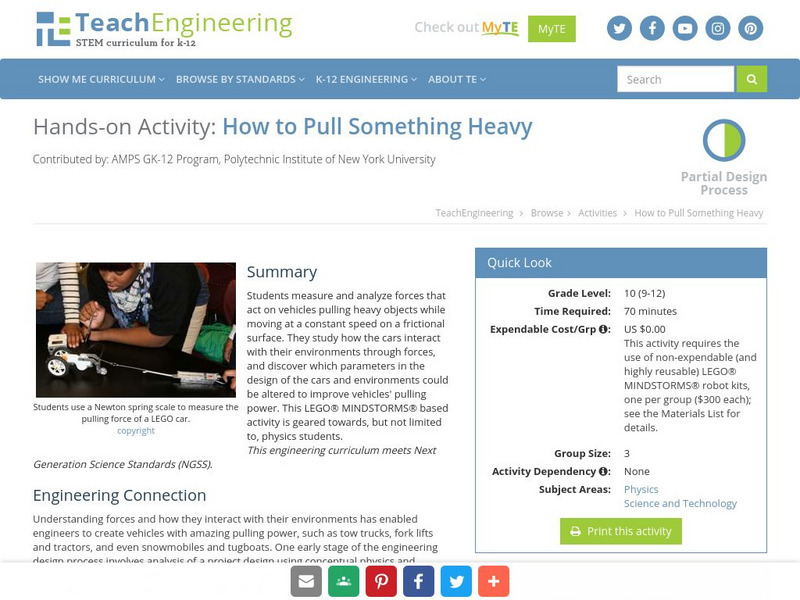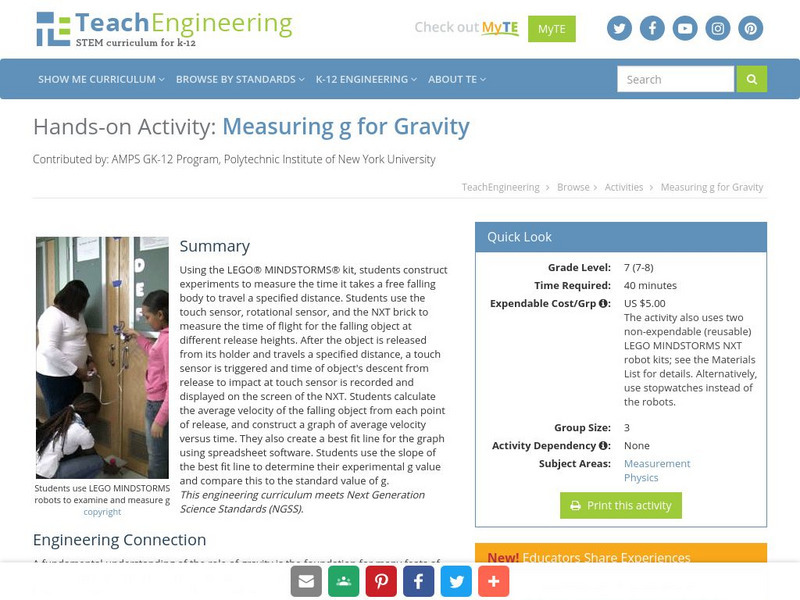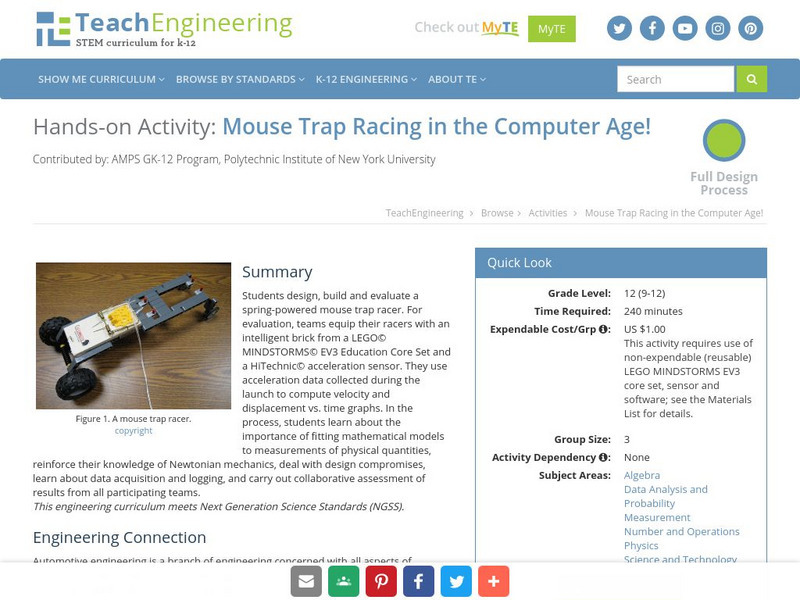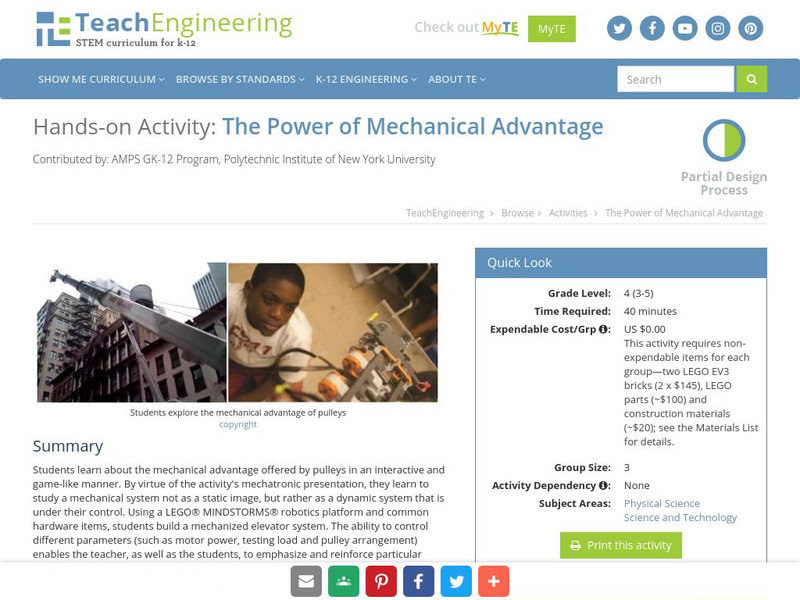Curated OER
Investigation 1 - Push and Pull
Third graders study the forces of push and pull on motion
Curated OER
Identifying Forces
Students identify, describe and indicate direction and relative magnitude of forces. In this motion instructional activity students work in groups to identify the force that is described to them.
Curated OER
Types of Forces
Young scholars study scientific names and descriptions of forces. In this motion lesson students organize information into a graphic organizer then teach it to other young scholars.
Curated OER
How do forces combine?
In this calculus-based activity, students experiment how to add forces in order to get a net force of zero with no acceleration while following the directions of a variety of different scenarios.
Curated OER
Hit Me With Your Best Shot
Sixth graders discuss the effect of gravity on objects. In groups, they participate in different activities in which they observe the effect of motion on objects and how energy is transferred between objects. To end the instructional...
Curated OER
Forces and Acceleration
Pupils discover the relationship between force and acceleration in a skateboard experiment. In small groups, they attach a spring balance to a skateboard and pull a group member across the floor using a constant amount of force. They...
Curated OER
Traveling Bowls
Learners investigate the relationship between force and motion while conducting an experiment to answer the question,"How do objects move?". In small groups, they predict how many washers are needed to pull a bowl across a finish line.
Curated OER
Marvelous Magnets
Students identify and classify magnetic and nonmagnetic materials and metals. After determining which materials and metals are magnetic, students create a data table and classify items by two different criteria. Students e-mail various...
Curated OER
In-Line Inertia
Students practice calculating the moment of inertia when discussing a skater and the position in which it is best to spin. After class discussion, students practice calculating inertia on their own.
Curated OER
What Makes a Kite Fly?
Ninth graders compare the nature of forces of gravity, lift, thrust, and drag. They select proper materials for making a kite and attach a proper tail. Students interpret and summarize the observations made during the flight of the kites.
Curated OER
Straight Line Motion
Fourth graders compare/contrast and interpret data concerning different objects straight line motion. They observe several round or spherical objects of various materials and sizes. Students make predictions, observe and collect data...
Curated OER
Forces in a Climb - Vectors
High schoolers read Forces in a Climb from the Beginner's Guide to Propulsion, and explain each of the formulas using vectors.
Curated OER
Forces in Action
Pupils ask questions that can be investigated scientifically. They determine how to plan a fair test by changing one factor while keeping other factors the same, to use measurements to draw conclusions and use scientific knowledge to...
Curated OER
Investigation 4 - Collision Zone
Third graders study how forces of push and pull can change speed or direction.
Curated OER
Bicycle Pump Pressure
Students explain that air pressure applies a force. If any of students have flown in an airplane, they have felt the "popping" of their ears caused by the change in atmospheric pressure because of the altitude changes.
University of Colorado
University of Colorado: Ph Et Interactive Simulations: Forces and Motion
Explore the forces at work when you try to push a filing cabinet. Create an applied force and see the resulting friction force and total force acting on the cabinet. Charts show the forces, position, velocity, and acceleration vs. time....
University of Colorado
University of Colorado: Ph Et Interactive Simulations: Forces in 1 Dimension
Explore the forces at work when you try to push a filing cabinet. Create an applied force and see the resulting friction force and total force acting on the cabinet. Charts show the forces, position, velocity, and acceleration vs. time....
TeachEngineering
Teach Engineering: Friction Force
Students use LEGO MINDSTORMS robotics to help conceptualize and understand the force of friction. Specifically, they observe how different surfaces in contact result in different frictional forces. A LEGO robot is constructed to pull a...
TeachEngineering
Teach Engineering: How to Pull Something Heavy
Students measure and analyze forces that act on vehicles pulling heavy objects while moving at a constant speed on a frictional surface. They study how the cars interact with their environments through forces, and discover which...
TeachEngineering
Teach Engineering: Measuring G
Using the LEGO MINDSTORMS NXT kit, students construct experiments to measure the time it takes a free falling body to travel a specified distance. Students use the touch sensor, rotational sensor, and the NXT brick to measure the time of...
TeachEngineering
Teach Engineering: Measuring Pressure
Students learn first-hand the relationship between force, area and pressure. They use a force sensor built from a LEGO MINDSTORMS NXT kit to measure the force required to break through a paper napkin. An interchangeable top at the end of...
TeachEngineering
Teach Engineering: Mouse Trap Racing in the Computer Age!
Students design, build and evaluate a spring-powered mouse trap racer. For evaluation, teams equip their racers with an intelligent brick from a LEGO MINDSTORMS NXT Education Base Set and a HiTechnic acceleration sensor. They use...
TeachEngineering
Teach Engineering: The Power of Mechanical Advantage
Students learn about the mechanical advantage offered by pulleys in an interactive and game-like manner. By virtue of the activity's mechatronic presentation, they learn to study a mechanical system not as a static image, but rather as a...

























